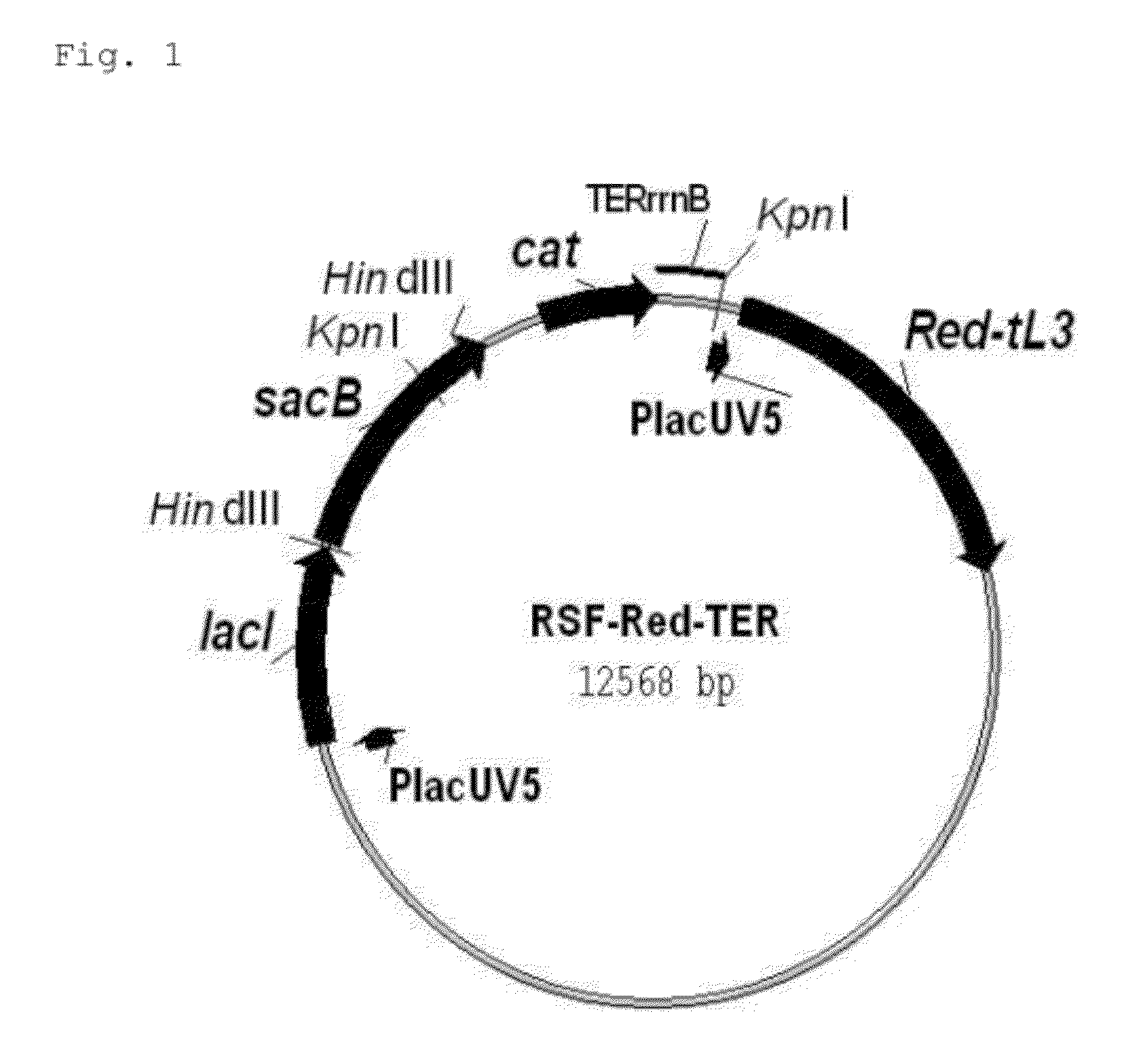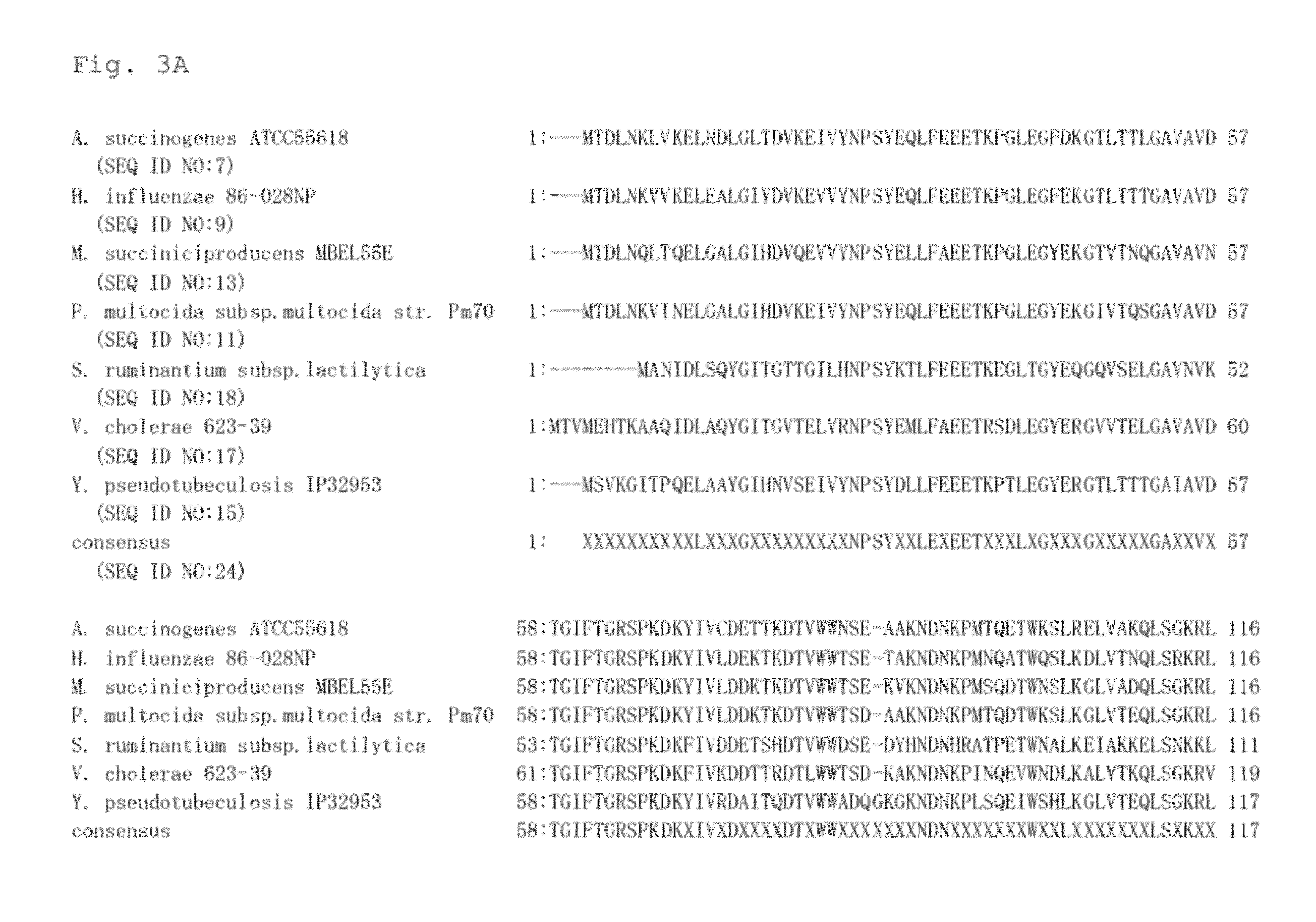Method for producing an organic acid
a technology of organic acid and production method, which is applied in the direction of fermentation, biochemistry apparatus and processes, microbiological testing/measurement, etc., can solve the problems of increased cost of culture medium, increased purification cost of isolating product, and inconvenient use, so as to achieve higher production efficiency
- Summary
- Abstract
- Description
- Claims
- Application Information
AI Technical Summary
Benefits of technology
Problems solved by technology
Method used
Image
Examples
example 1
[0139] Acquisition of the Threonine Operon Promoter Fragment from the Escherichia coli MG1655 Strain
[0140]The entire genomic nucleotide sequence of Escherichia coli (Escherichia coli K-12 strain) has already been elucidated (Genbank Accession No. U00096, Science, 277, 1453-1474 (1997)). On the basis of this sequence, the promoter region of the threonine operon (thrLABC) was amplified by PCR using a synthetic oligonucleotide having a SacI site (SEQ ID NO: 1) as the 5′ primer, a synthetic oligonucleotide (SEQ ID NO: 2) as the 3′ primer, and genomic DNA from the Escherichia coli MG1655 strain (ATCC 47076, ATCC 700926) as the template. As a result, the threonine operon promoter fragment (A) (SEQ ID NO: 3) was obtained.
[0141] Acquisition of a Phosphoenolpyruvate Carboxykinase Gene Fragment from the Actinobacillus succinogenes 130Z Strain (ATCC 55618)
[0142]The entire genomic nucleotide sequence of the Actinobacillus succinogenes 130Z strain has also already been elucidated (GenBank Access...
example 2
[0147] Construction of ptsG-Deficient Strain of Enterobacter aerogenes AJ110637
[0148]The ptsG gene coding for glucose phosphotransferase of the Enterobacter aerogenes AJ110637 was deleted.
[0149]A gene fragment to be used for the deletion of ptsG was prepared by PCR using the pMW118-(λattL-Kmr-λattR) plasmid (see Reference Example 3) as the template, and the oligonucleotides of SEQ ID NOS: 22 and 23 as the primers. pMW118-(λattL-Kmr-λattR) was obtained by inserting the attL and attR genes, which are the attachment sites of λ phage, and the Km gene, which is an antibiotic resistance gene, into pMW118 (Takara Bio), in the following order: attL-Kmr-attR (see Reference Example 3). By PCR described above, a gene fragment containing a kanamycin resistance gene, attL and attR sequences of λ phage at the both ends of kanamycin gene, and 60 bp of the upstream sequence and 59 bp of the downstream sequence of the ptsG gene added to the outer ends of the λ phage sequences was amplified. This fra...
example 3
Effect of ΔptsG+pckA Amplification in a Succinic Acid-Producing Strain from Enterobacter bacterium
[0154]The Enterobacter aerogenes AJ110637+pSTV28, the Enterobacter aerogenes AJ110637ΔptsG+pSTV28, Enterobacter aerogenes AJ110637+pSTV28::Pthr::pckA and the Enterobacter aerogenes AJ110637ΔptsG+pSTV28::Pthr::pckA were each uniformly applied to an LB plate containing 40 mg / L of chloramphenicol, and cultured at 37° C. for 16 hours. Then, each plate was put into Anaeropack (for compromised culture of anaerobes, Mitsubishi Gas Chemical, product number A-04), and incubated at 37° C. for 16 hours under anaerobic conditions. The cells which appeared on the plate were washed with 0.8% brine and suspended so that the resulting cell suspension has an OD=1.0 (600 nm) after 250-times dilution. This cell suspension in a volume of 100 μl, and a production medium in a volume of 1.3 ml in which dissolved gases in the medium were replaced with carbon dioxide beforehand, were put into a 1.5-ml volume m...
PUM
| Property | Measurement | Unit |
|---|---|---|
| temperature | aaaaa | aaaaa |
| temperature | aaaaa | aaaaa |
| temperature | aaaaa | aaaaa |
Abstract
Description
Claims
Application Information
 Login to View More
Login to View More - R&D
- Intellectual Property
- Life Sciences
- Materials
- Tech Scout
- Unparalleled Data Quality
- Higher Quality Content
- 60% Fewer Hallucinations
Browse by: Latest US Patents, China's latest patents, Technical Efficacy Thesaurus, Application Domain, Technology Topic, Popular Technical Reports.
© 2025 PatSnap. All rights reserved.Legal|Privacy policy|Modern Slavery Act Transparency Statement|Sitemap|About US| Contact US: help@patsnap.com



